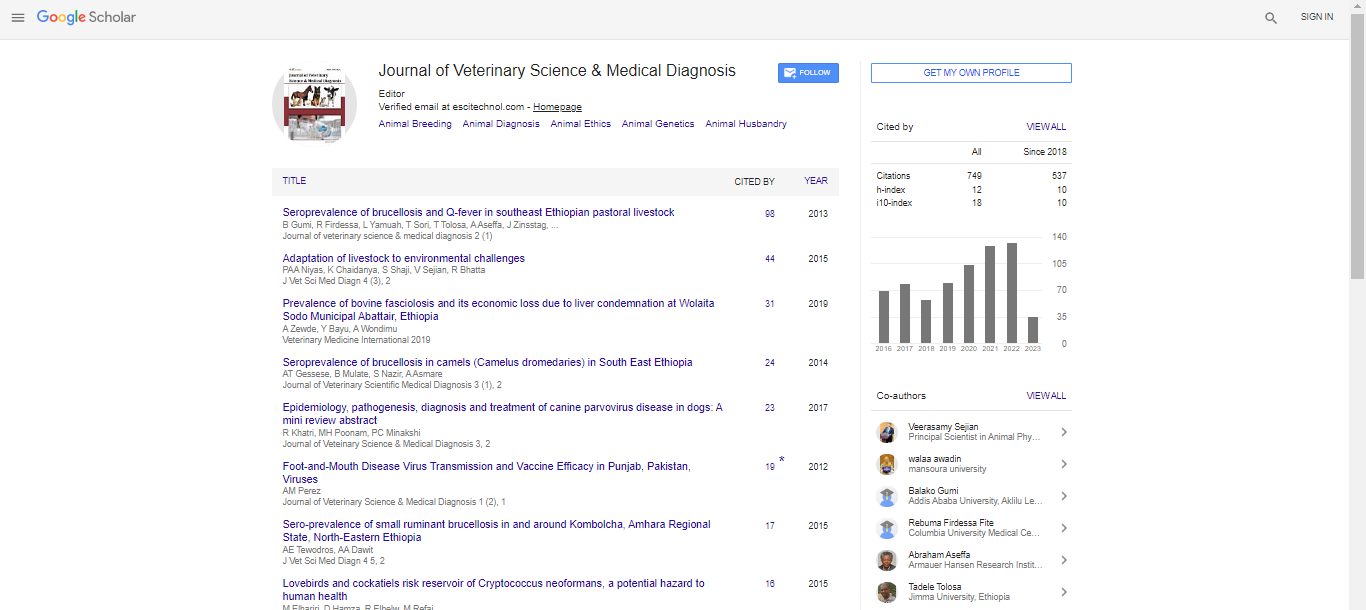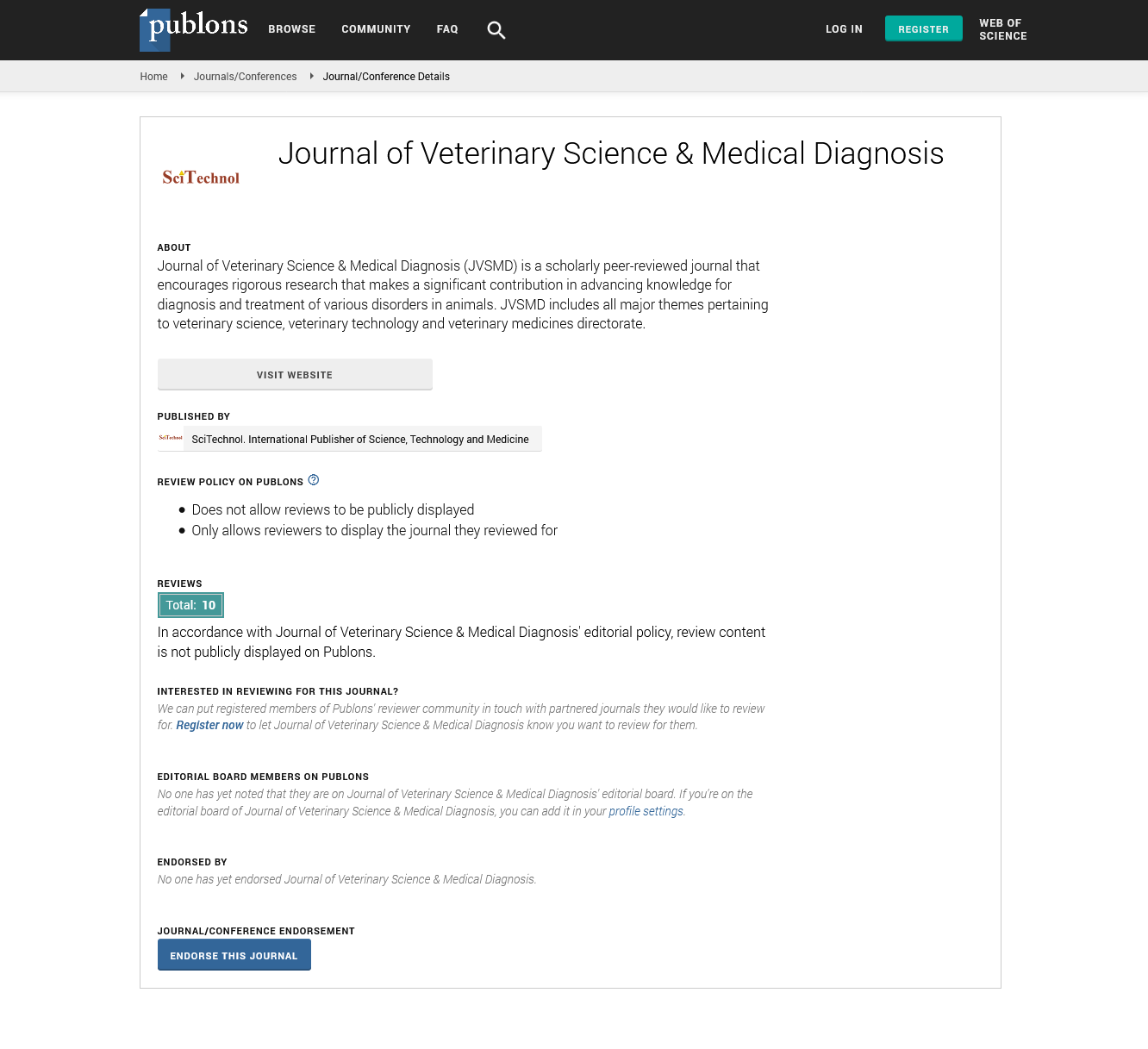Commentary, J Vet Sci Med Diagn Vol: 13 Issue: 2
Nutritional Approaches to Maximize Milk Yield and Quality in Dairy Cattle
Cogan Smith*
Department of Veterinary and Agricultural Sciences, The University of Melbourne, Melbourne, Australia
- *Corresponding Author:
- Cogan Smith
Department of Veterinary and Agricultural Sciences,
The University of Melbourne,
Melbourne,
Australia;
E-mail: cogan@yahoo.com
Received date: 13 March, 2024, Manuscript No. JVSMD-24-154230;
Editor assigned date: 15 March, 2024, PreQC No. JVSMD-24-154230 (PQ);
Reviewed date: 29 March, 2024, QC No. JVSMD-24-154230;
Revised date: 09 April, 2024, Manuscript No. JVSMD-24-154230 (R);
Published date: 16 April, 2024, DOI: 10.4172/2325-9590.1000092
Citation: Smith C (2024) Nutritional Approaches to Maximize Milk Yield and Quality in Dairy Cattle. J Vet Sci Med Diagn 13:2.
Description
The dairy industry heavily depends on the efficient production of milk, both in terms of quantity and quality. To achieve optimal milk production, it is important to address the nutritional needs of dairy cattle through targeted feeding strategies [1]. Proper nutrition influences not only milk yield but also its composition, including fat, protein and lactose content. Maximizing milk yield and quality in dairy cattle requires a combination of strategic nutrition management, balancing energy and protein intake and meeting the specific needs of dairy cows at different stages of lactation [2].
One of the most important factors in optimizing milk yield is ensuring adequate energy intake. Dairy cattle, particularly highproducing cows, require a substantial amount of energy to meet the demands of lactation. Insufficient energy intake can lead to negative energy balance, reduced milk production and even metabolic disorders like ketosis [3]. Therefore, it is essential to provide a diet that meets or exceeds the energy requirements of lactating cows. High-energy feeds such as grains, fats and silage are often incorporated into the diet to support the energy demands of dairy cattle [4]. For instance, corn silage is commonly used in dairy rations as it provides both energy and fibre, essential for proper rumen function.
Protein is another major nutrient that affects both milk yield and quality. Protein is essential for the synthesis of milk proteins such as casein, which contributes to milk’s nutritional value. Ruminants rely on microbial protein synthesized in the rumen, along with high-quality protein from their diet [5]. Adequate protein intake promotes optimal growth, reproduction and milk production. High-quality protein sources like soybean meal, alfalfa and canola meal are typically included in dairy rations. The balance of Rumen-Degradable Protein (RDP) and Rumen-Undigestible Protein (RUP) is vital. Too much RDP can lead to inefficient nitrogen utilization, while insufficient RUP can reduce protein synthesis for milk production [6]. Therefore, a carefully balanced diet is necessary to support both the rumen microbes and the cow’s milk production.
In addition to energy and protein, micronutrients such as vitamins and minerals play a major role in maximizing milk quality. Calcium, phosphorus and magnesium are essential for bone health and milk production, as these minerals are involved in the proper functioning of the cow’s metabolism and muscle contractions during lactation [7]. Deficiencies in these minerals can lead to conditions like milk fever, which affects cows post-calving and impairs their ability to produce milk [8]. The addition of trace minerals such as zinc, copper and selenium also supports immune function, helping dairy cows to resist infections that could negatively impact milk production.
Moreover, the incorporation of fiber into the diet is essential for maintaining proper rumen health, which in turn ensures efficient digestion and nutrient absorption [9]. Forages such as alfalfa and grasses are rich in fiber and help promote rumen fermentation. Adequate fiber intake is necessary to maintain rumen motility, reduce the risk of acidosis and optimize the cow's ability to digest and absorb nutrients [10]. Balanced fiber intake ensures that cows can process the energy and protein they consume efficiently, which directly affects milk production and quality.
In conclusion, the nutritional management of dairy cattle is important for maximizing both milk yield and quality. By providing balanced diets rich in energy, protein, fiber, vitamins and minerals, dairy farmers can improve the efficiency of milk production while maintaining cow health [11,12]. Proper nutrition throughout the lactation cycle is key to achieving high milk yields and ensuring that milk remains of high quality, ultimately benefiting both producers and consumers in the dairy industry [13].
References
- Van Eenennaam AL, Young AE (2017) Detection of dietary DNA, protein, and glyphosate in meat, milk, and eggs. J Anim Sci 95: 3247-3269.
[Crossref] [Google Scholar] [PubMed]
- Tremblay M, Hess JP, Christenson BM, McIntyre KK, Smink B, et al. (2016) Factors associated with increased milk production for automatic milking systems. J Dairy Sci 99: 3824-3837.
[Crossref] [Google Scholar] [PubMed]
- Tosta MR, Prates LL, Christensen DA, Yu P (2019) Effects of processing methods (rolling vs. pelleting vs. steam-flaking) of cool-season adapted oats on dairy cattle production performance and metabolic characteristics compared with barley. J Dairy Sci 102: 10916-10924.
[Crossref] [Google Scholar] [PubMed]
- Schingoethe DJ (2017) A 100-Year Review: Total mixed ration feeding of dairy cows. J Dairy Sci 100: 10143-10150.
[Crossref] [Google Scholar] [PubMed]
- Rook AJ, Huckle CA, Penning PD (1994) Effects of sward height and concentrate supplementation on the ingestive behaviour of spring-calving dairy cows grazing grass-clover swards. Appl Anim Behav Sci 40: 101–112.
- Roche JR, Kolver ES, Berry DP (2006) Holstein-Friesian strain and feed effects on milk production, body weight, and body condition score profiles in grazing dairy cows. J Dairy Sci 89: 3532–3543.
[Crossref] [Google Scholar] [PubMed]
- Migliorati L, Speroni M, Susanna L, Calza F (2005) Effect of concentrate feeding on milking frequency and milk yield in an automatic milking system. Ital J Anim Sci 4: 221-223.
- Lopes JC, Harper MT, Giallongo F, Oh J, Smith L, Ortega-Perez AM, et al. (2017) Effect of high-oleic-acid soybeans on production performance, milk fatty acid composition, and enteric methane emission in dairy cows. J Dairy Sci 100: 1122–1135.
[Crossref] [Google Scholar] [PubMed]
- Bach A (2014) Precision feeding to increase efficiency for milk production,West. Can Dairy Semin Adv Dairy Technol 26: 177-189.
- Clark PW, Ricketts RE, Krause GF (1977) Effect on milk yield of moving cows from group to group. J Dairy Sci 60: 769-772.
- Contreras-Govea FE, Cabrera VE, Armentano LE (2013) Constraints for nutritional grouping in Wisconsin dairy farms. J Anim Sci 91: 540.
- Kroll O, Owen JB, Whitaker CJ (1987) Grouping and complete diet composition in relation to parity and potential yield in dairy cows. J Agric Sci 108: 281-291.
- Pinedo PJ, De Vries A, Webb DW (2010) Dynamics of culling risk with disposal codes reported by Dairy Herd Improvement dairy herds. J Dairy Sci 93: 2250-2261.
 Spanish
Spanish  Chinese
Chinese  Russian
Russian  German
German  French
French  Japanese
Japanese  Portuguese
Portuguese  Hindi
Hindi 
